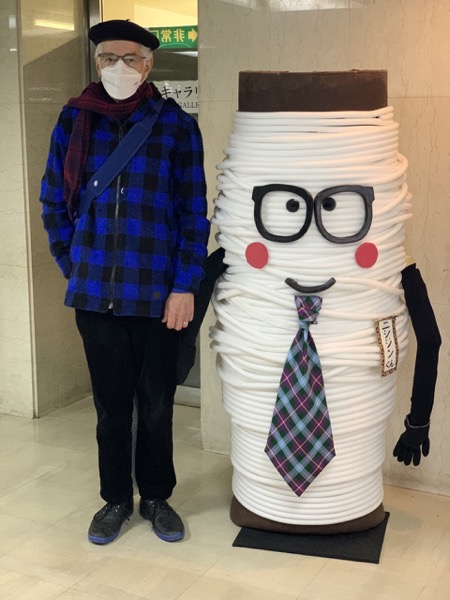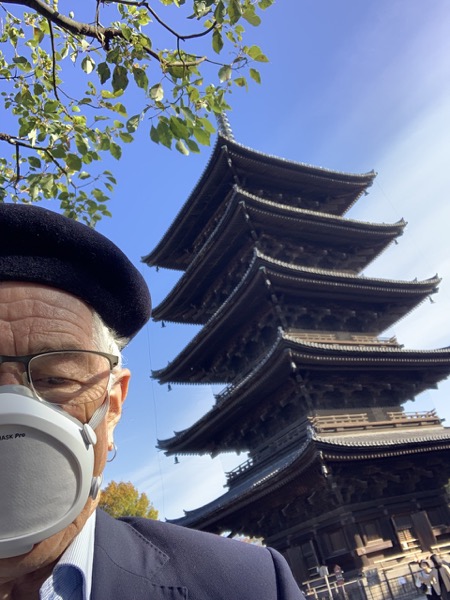Last Friday (December 5, 2025), I filmed an extended discussion with my Kyoto University colleague,…
Kyoto Report No 8
This Tuesday report will provide some insights into life in Kyoto for a westerner in the age of Covid. I know I said last week’s Report would be the last but I have a couple of more observations in the days that followed. So here we are again for the last report for this year. I will continue the series when I return to Kyoto in 2023.
Textiles again
The other day I rode by bike back to the Textile Centre to show a friend all the great old machines and other things there.
This photo shows me with Mr Textile who sits at the entrance and welcomes visitors to the Centre.
I hope you can tell the difference.
I am the guy with glasses!
Unfortunately, we arrived close to closing and so we will have to save a full excursion through all the machines until next year.
Tō-ji Temple
On Friday, I was down at the main station and had a few hours free before catching the – Nozomi – back to Shinagawa (Tokyo) and then another suburban JR train to Haneda for a late night flight back to Australia.
I put my travel bags into a Cloak facility near the central Kyoto station (ecbo – which is very good and not expensive) and walked around to the Tō-ji – Temple complex, which is about 20 minutes walk south west of the station.
In past visits to Kyoto, I had never been to this complex.
It is quite a place.
The engineers and designers knew a few things in those days.
The all wood construction is designed in such a way to resist earthquakes. Each storey is designed to shake independently (like a ‘snake’) and the various wooden support struts are constructed to shift torque back to the centre of the structure to avoid instability.
It is a marvellous feat and an amazing building.
Here I am propping up the famous five-storey pagoda (五重塔), which was built during the Edo period in 1643, after previous pagodas had been destroyed by fire.
There are other fabulous buildings in the complex.
The Kondo Hall or “Golden Hall is the main hall of the temple and contains a statue of Yakushi from 1603”.
It has three large golden statues – the so-called ‘Yakushi Triad’ – on the elevated stage.
The wooden beams that support the structure are huge.
The Yakushi were considered to be the ‘Medicine Buddha’ who would pray to the statues in the hope of cures for various ailments. On either side are the statues depicting the ‘nurses’, one for the night and another for the day.
These are the Nikko and Gakko Bodhisattvas who have delayed the journey to enlightenment in order to help humanity.
I learned this from a kind Japanese guy who saw us reading the signs in the temple and came across and offered his assistance.
I then received the full story of the 24/7 health care provision from the statues.
Another building next door to the Kondo Hall us – the Kodo Hall – which dates back to 825 and was the main educational lecture hall for the complex.
The current building replaced one that was burned down in the great fire of 1486 and was replicated later in its current state.
There are 19 statues in this building (arranged as in the mandala).
Another great building.
Signing off
So that is Kyoto for 2022.
In the coming period, I plan to learn more kanji so I can read newspapers and all the signs.
I am also going to finish the language course I have started and then do an advanced course.
By the time I return in 2023, I hope to be relatively fluent and that will open even more opportunities to have fun.
There is something stifling about holding an iPhone up to signs in order to translate them when the hiragana and kanji count exceeds the number you know.
That is enough for today!
(c) Copyright 2022 William Mitchell. All Rights Reserved.


This Post Has 0 Comments